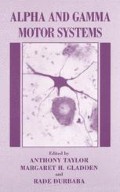Abstract
The hatchling tadpole of Xenopus laevis has been used successfully as a simple model system in which to study the spinal neural circuits that control locomotion (Roberts, 1990). It is therefore an ideal simple system in which to study possible functions for central synapses made by spinal motoneurones. Such synapses are known to exist, being made on premotor interneurones (for example Renshaw cells) as well as on other motoneurones, in a variety of vertebrates from fish to adult mammals. However, very little is known of their role during locomotion, which is probably in part due to the complexity of the systems in which they have been found (e.g. Noga, Shefchyk, Jamal & Jordan, 1987). We have recently shown that motoneurones are integral parts of the simple Xenopus circuit which produces the drive during swimming, rather than just being output devices to the muscles, as was previously supposed. By making simultaneous intracellular recordings from pairs of spinal motoneurones we have directly demonstrated the presence of cholinergic synapses between motoneurones, the activation of which gave rise to fast EPSPs which were blocked by nicotinic antagonists (Perrins & Roberts, 1995; Figure 1A). A more local electrical coupling between motoneurones was also sometimes observed (Perrins & Roberts, 1995). Both these types of interaction were only found between motoneurones on the same side of the spinal cord. For these pairs about 50% were chemically coupled and 10% electrically coupled. Since motoneurones on the same side of the spinal cord spike roughly in phase, excitation from these two types of connection would be expected to occur on-cycle during swimming. We therefore investigated the composition of the fast on-cycle excitation which underlies spiking activity in spinal neurones, which had previously been thought to be due entirely to kainate/AMPA receptor activation by an excitatory amino acid. By the local application of the nicotinic antagonists dihydro-β-erythroidine and d-tubocurarine (both 10 µM), we showed that 20% of the on-cycle excitation received by motoneurones during swimming is provided by cholinergic EPSPs. The local application of 100 µM Cd2+, which blocks all chemical neurotransmission, demonstrated that 50% of the fast on-cycle excitation was due to electrotonic coupling with other, spiking neurones. The anatomical simplicity of the Xenopus spinal cord (which contains just eight morphological classes of neurone; Roberts & Clarke, 1982), along with the results of the paired recording study mean that the most likely source for these two types of excitation is other motoneurones. The local application of CNQX showed that the remaining 30% of the fast excitation was due to kainate/AMPA receptor activation.
Access this chapter
Tax calculation will be finalised at checkout
Purchases are for personal use only
References
Noga, B. R., Shefchyk, S. J., Jamal, J. & Jordan, L. M. (1987). The role of Renshaw cells in locomotion: antagonism of their excitation from motor axon collaterals with intravenous mecamylamine. Exp. Brain Res. 66, 99–105.
Perrins, R. & Roberts, A. (1995) Cholinergic and electrical synapses between synergistic spinal motoneurones in the Xenopus laevis embryo. J. Physiol. (in press).
Roberts, A. (1990) How does a nervous system produce behaviour? A case study in neurobiology. Sci. Prog. 74, 31–51.
Roberts, A. & Clarke, J. D. W. (1982) The neuroanatomy of an amphibian embryo spinal cord. Phil. Trans. R. Soc. Lond. B 269, 195–212.
Author information
Authors and Affiliations
Editor information
Editors and Affiliations
Rights and permissions
Copyright information
© 1995 Springer Science+Business Media New York
About this chapter
Cite this chapter
Perrins, R. (1995). The Roles of Central Cholinergic and Electrical Synapses made by Spinal Motoneurones in Xenopus Embryos. In: Taylor, A., Gladden, M.H., Durbaba, R. (eds) Alpha and Gamma Motor Systems. Springer, Boston, MA. https://doi.org/10.1007/978-1-4615-1935-5_9
Download citation
DOI: https://doi.org/10.1007/978-1-4615-1935-5_9
Publisher Name: Springer, Boston, MA
Print ISBN: 978-1-4613-5793-3
Online ISBN: 978-1-4615-1935-5
eBook Packages: Springer Book Archive

